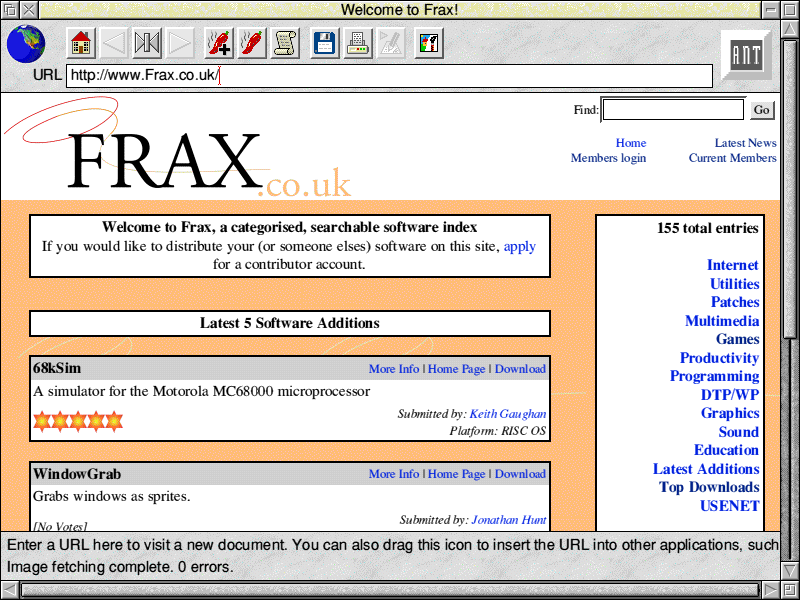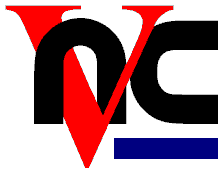



PD World
Alasdair Bailey takes RISC World readers through the world of PD and Shareware.
Welcome to this, the second issue of PD World. This time we'll be looking at another selection of the best of general PD software. However, next issue, I'll be taking a closer look at internet-related PD/shareware. Please let me know of any new developments or bits of software you use in this area so I can offer as complete a coverage as possible.
Frax

The front page of Frax, a new freeware software index for RISC OS.
The Frax web site is a brand-new searchable software index for RISC OS PD, freeware and shareware. With download links also included to all items listed, this web site could well render the FTP sites and bulletin boards of yesteryear redundant.
The whole Frax system is fully automated, meaning that anyone can quickly and easily submit a new item by registering as a member and then entering some rudimentary information about the software along with a download URL which others can follow. Once this process is complete and the submission has been moderated, the new item will appear in one of the site's categorised sections. From here, others may download it and even add a one to five star rating to let future punters know what they're getting for their download time.
At the moment, there's a fair few bits of software on Frax and it's well worth a look if you're after a particular utility. The great thing about sites like these is that - provided enough people submit software - they become a one stop shop for PD/shareware and remove the need to traipse around numerous authors' web sites to find the right program. Of course, there are links to web sites on Frax too, just in case you want more information.
The automated nature of Frax also means that it is fully searchable by keyword, phrase or submitter. Take a look at Frax when you have a moment at http://www.frax.co.uk/
Back It Up
BackMan is a well-documented hard disc backup suite from Matthew Sackman. It is a very usable and reliable utility and its range of features means that it can be tailored to suit most needs. As would be expected, all the usual bits and bobs are supported, including incremental backups and also use with removable media such as Zip and floppy discs.
One feature lacking in the current release is the compression of backed-up files. This is vital to conserve costly storage media but can be worked around by setting BackMan to use an empty archive as its destination directory, provided you have the full version of either SparkFS or ArcFS.
BackMan's configuration window is a little scary at first sight but a quick read through the very comprehensive manual will set you right in no time. The use of HTML to produce manuals for PD and shareware apps is becoming ever more common and I like it. These days, almost all users will have access to a web browser (even if it's only one like as the off-line version of Fresco included on this very CD) and HTML makes the inclusion of images and data tables a doddle.
As a shareware offering, BackMan carries a £10 registration fee but in our opinion, it's well worth it. We've even included a copy of the unregistered version in the SOFTWARE directory on the CD for you to have a play with; for more information on the program, visit the BackMan web site at: http://www.sackman.co.uk/namkas/.
Big Brother is Watching!
 |
VNC (or Virtual Network Computing) is a client-server protocol to enable one network workstation to see the screen display of another. This can even be extended to allow the client to pass keyboard and mouse buffer data back to the server. But what use is all of this? Well, it means that if you regularly use more than one computer on a network, you can set up VNC to allow you to use one machine remotely and save all that desk swopping. |
Another use of VNC is to keep an eye on what your pupils (or employees) are doing whilst they should be working. By setting up all the machines in a classroom or office to accept password-protected VNC connections, an administrator can periodically log in and check on what's going on at the other end.
The great thing about all this is that you can even do it from RISC OS. Provided you have a fast enough network card, the display of the computer being remotely viewed appears in a window under RISC OS and any keyboard or mouse actions carried out while the window is active are passed on to the remote machine. The system is highly configurable with options existing to control what's passed to the remote machine as well as the type of compression used to minimise the network traffic.
In testing between my Risc PC and PC, the system was found to work well in both directions even using the ancient 200KB/s network card fitted in the Acorn. Screen mode changes and hardware accelerated display modes mess things up on occasion but so long as you stay within the confines of the desktop, this solution can feel just like a supercharged PC card from the Acorn side.
Clients and servers are available for most platforms and all are free to download. Take a look at http://www.orl.co.uk/vnc/ for more info and downloads of Acorn and PC clients and servers.
Do You Samba?

While on the subject of networking, the RISC OS port of Samba deserves a quick mention. This port, brought to us by David Buxton, allows PC (and Linux/Mac) users to access drives and printers on a RISC OS machine across a TCP/IP network. Previously, this sort of software would have cost an arm and a leg but this port of the native Linux drive sharing software makes things a whole lot easier.
Samba, combined with the commercial LanMan98 for accessing the Windows drives, can help to build a seamless network between an Acorn and PC at very little cost over that of the network cards and cabling. Take a look at the RISC OS Samba home page at http://www.merddin.demon.co.uk/riscos.htm for the download and more info on the program.
Skinned Alive
Andrew Hill's excellent Matrix themed skin |
 |
MP3 players have received a lot of coverage lately in the RISC OS press so I won't draw this item out. Basically, I've included a copy of DigitalCD and a selection of the best skins for use with it on the CD for your musical benefit.
DigitalCD is one of a handful of MP3 music player front-ends for RISC OS, and these rather cryptic sounding skins allow you to customise the look and feel of the player's windows. They're essentially just new sets of window furnishings for the player to use in its windows.
A copy of DigitalCD is included in the SOFTWARE directory on the CD with the following skins.- Evil
- Ferrari
- LCARS
- Lunatic
- Midnight
- Realities
- Sonix
- Matrix
- Wood
- AudioBump
- Cthugha
- Firecom
- TimVis
For more skins, plug-ins and up-to-date versions, see the DigitalCD web site at: http://www.geocities.com/SiliconValley/Horizon/4471/dev.htm.
JPEG Cleaning
And finally, news of a small utility which will save some people an awful lot of trouble. JClean by David Barrow (a front end to work carried out by Jérôme Mathevet) allows the removal of all excess information from a JPEG image without re-compressing it and hence losing quality.
This can be very useful for users of certain models of digital camera which, even with the use of RISC OS connectivity software, still cause problems for SpriteExtend's super-quick display routines. Without stripping excess data, the display of pictures from cameras such as Nikon's excellent CoolPix 800 has to be done with something slower and less fussy like ChangeFSI.
There's a copy of JClean on the CD for you all to use.
'Till next time, goodbye!
Alasdair Bailey